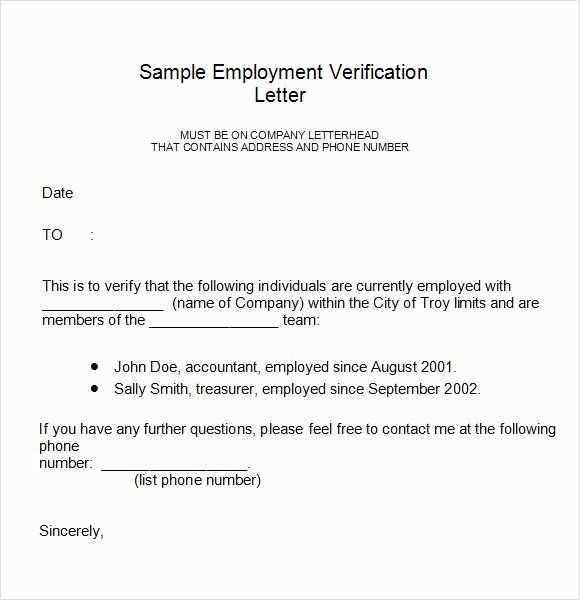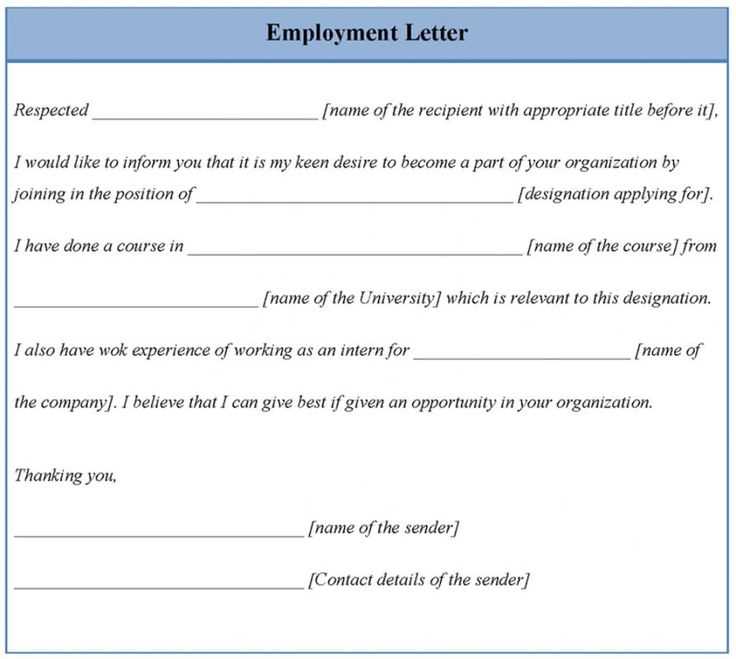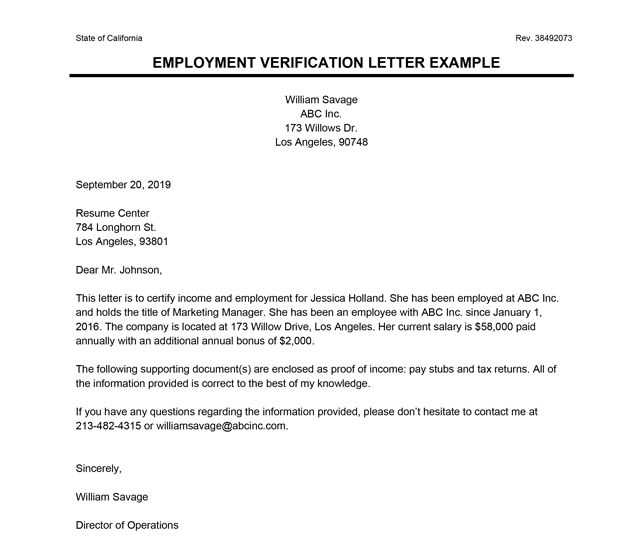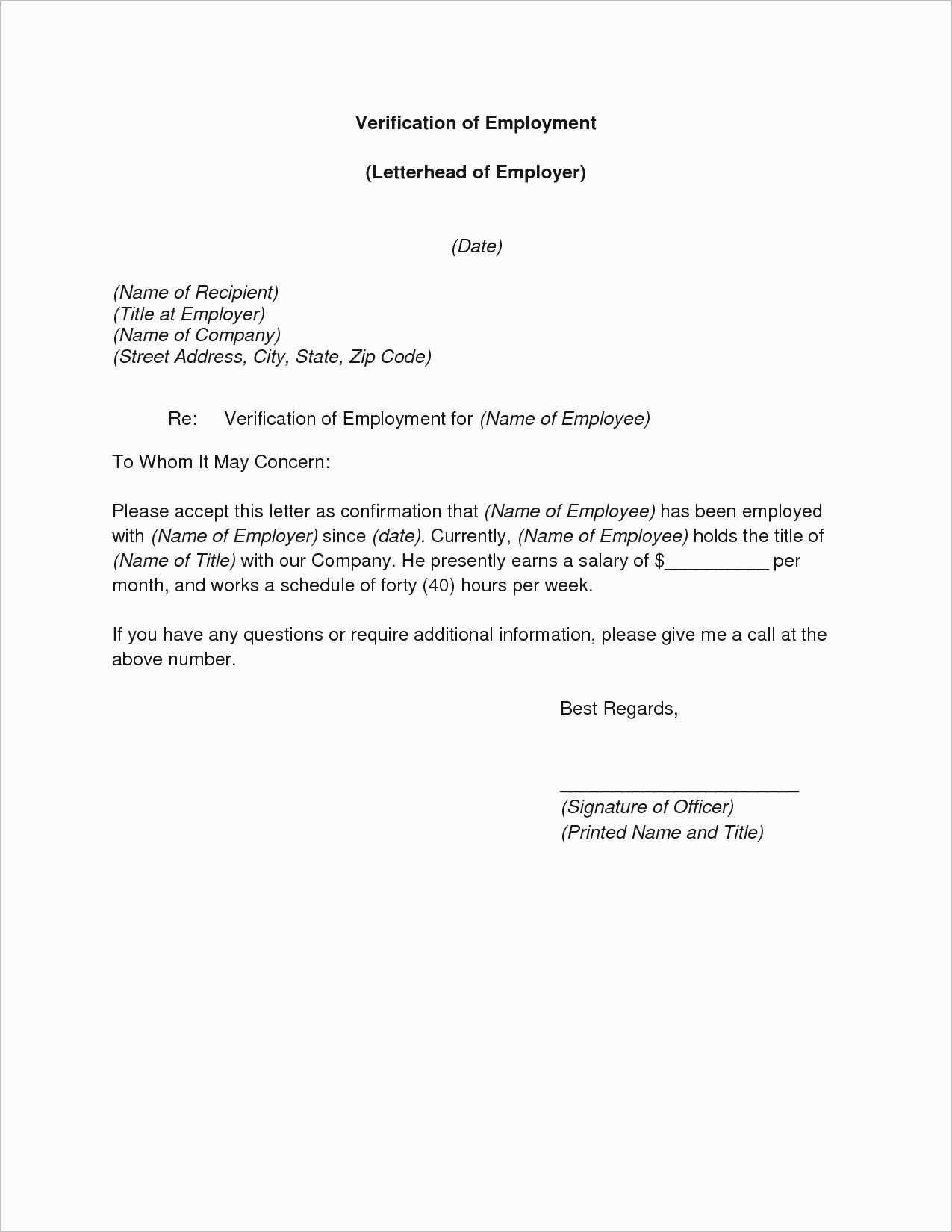Previous employment verification letter template

Start your employment verification letter with a clear introduction of the individual being verified. Include their full name, the position held, and the dates of employment. This provides the necessary context for the recipient to understand the verification being requested.
Follow with a statement confirming the details of the employment. This includes job title, key responsibilities, and the employee’s performance or contribution during the time of employment. Make sure the tone remains professional and objective.

End the letter with a confirmation of the employment status, including whether the person left voluntarily or was terminated, along with a brief mention of the reason if applicable. Ensure that the letter is concise and to the point, without adding any unnecessary details.
Don’t forget to close the letter with a thank you for the recipient’s time and attention, and provide your contact information for any follow-up inquiries. This maintains a helpful, approachable tone throughout the letter.
Here are the corrected lines:
Ensure the subject line is clear and professional. It should briefly state the purpose of the letter, such as “Verification of Previous Employment for [Employee Name].”
In the introduction, mention the purpose of the letter right away. Start with something like: “This letter is to confirm the employment details of [Employee Name], who worked with us at [Company Name] from [Start Date] to [End Date].”
State the employee’s position and briefly outline their responsibilities during their tenure. For example: “[Employee Name] held the position of [Job Title] and was responsible for [Key Responsibilities].”
Clarify the employment status by adding specific information about whether the employee left voluntarily or was terminated. If relevant, mention the reason for their departure.
Include any achievements or recognitions the employee received during their employment. This provides a positive tone and highlights their contributions to the company.
Conclude with a polite offer for further information. A suitable closing line might be: “Should you require additional information or clarification, please feel free to contact me at [Your Contact Information].”
- Previous Employment Verification Letter Template
Creating a precise and formal employment verification letter is key to providing clarity and authenticity. Below is a template to guide you:
| Section | Content Example |
|---|---|
| Employer’s Information | Company Name, Address, Phone Number, Email |
| Employee’s Information | Full Name, Job Title, Employment Dates |
| Letter Body | Details of the employee’s position, duties, and tenure. Mention dates of employment and any relevant achievements. |
| Closing | End with contact information for any further verification. |
This format ensures all required details are covered in a straightforward manner, helping to verify an employee’s previous job history with ease.
Keep the letter concise and to the point. It should include key details about the employee’s time at the company, such as job title, employment dates, and job duties. Below are the steps to properly format the letter:
- Header: Start with the company’s name, address, phone number, and email at the top of the letter. Include the date of writing below the header.
- Salutation: Address the letter to the recipient, using “To Whom It May Concern” if the name is unknown. Alternatively, use the specific name of the person if available.
- Introduction: Begin by confirming the employment status of the individual, stating their full name, job title, and the dates they were employed.
- Employment Details: Specify the start and end dates of employment. Include the employee’s responsibilities and roles within the company.
- Closing: End the letter with a statement offering further verification if needed. Sign off with “Sincerely,” followed by the name and title of the person issuing the letter.
- Formatting: Use professional and simple language. Ensure there is enough white space between paragraphs for easy readability.
Be clear and concise. Include the employee’s full name, job title, and dates of employment. This gives the recipient a clear understanding of the position the employee held and the time frame of their employment. Make sure to verify the specific department or role if it’s relevant.
Provide the nature of the employee’s responsibilities and duties during their time in the position. This will give context to their skills and job performance. If available, briefly mention any promotions or significant accomplishments.
Ensure you include a statement confirming whether the employee was in good standing and whether they left voluntarily or were terminated. This confirms the reasons behind their departure and adds credibility to the letter.
Include the contact information of the person verifying the employment, such as a manager or HR representative. This allows the recipient to follow up for any additional information or clarification.
| Information | Details |
|---|---|
| Employee’s Name | [Full Name] |
| Job Title | [Job Title] |
| Dates of Employment | [Start Date] – [End Date] |
| Job Responsibilities | [Brief Description] |
| Reason for Departure | [Voluntary or Involuntary] |
| Contact Information | [Name, Position, Email, Phone Number] |
Ensure accuracy in all details. A common mistake is to provide incorrect or vague information about job titles, dates of employment, or job duties. Always double-check the dates and job descriptions before finalizing the letter.
Be Specific About Dates and Job Titles

Avoid generalizations. It’s critical to include specific start and end dates for employment, as well as the exact job title held by the employee. This helps the recipient verify the information easily and eliminates confusion.
Use Clear and Concise Language

Avoid using overly complex phrases or unnecessary jargon. Keep the language simple and direct. Clear communication ensures that the recipient understands the details right away, without second-guessing the intent of the letter.
Double-check the format. Formatting errors such as inconsistent fonts or layout can make a verification letter look unprofessional. Keep the document neat and structured, using a formal letter format that includes the date, subject, and appropriate salutation.
Remember to sign the letter. Many letters go unacknowledged because they are unsigned. Always sign the verification letter to validate its authenticity.
Tailor your previous employment verification letter by focusing on the specific skills and responsibilities that align with the job position. For instance, if you’re writing for a managerial role, highlight leadership qualities, project management skills, and any experience overseeing teams or departments. Mentioning measurable achievements, such as meeting or exceeding targets, will further demonstrate suitability for the position.
For technical positions, emphasize the applicant’s technical skills, proficiency with software or equipment, and any problem-solving experiences. Make sure to note any certifications or specialized knowledge that would be relevant to the job. This makes the letter more aligned with the technical demands of the role.
For customer-facing jobs, focus on the candidate’s communication skills, ability to handle difficult situations, and experience with customer satisfaction. Examples of positive customer interactions or sales achievements are helpful in this context. Highlight interpersonal skills and responsiveness, which are key for these positions.
Each letter should reflect the specific nature of the position while remaining truthful about the employee’s contributions and capabilities during their time at the company. Make the necessary adjustments to fit the context without overloading the letter with irrelevant details.
Ensure the accuracy of all information included in the employment letter. Verify employment dates, job titles, and responsibilities. Any false or misleading details can lead to legal issues, especially if the recipient uses the letter for official purposes.
Avoid including personal opinions or subjective statements. Keep the tone factual and professional to prevent potential defamation claims. Stick to verifiable facts such as job performance, employment history, and roles within the company.
Be mindful of confidentiality. Do not disclose private or sensitive information about the employee, such as medical history, salary details, or personal matters, unless explicitly authorized. Breaching privacy laws can result in penalties.
Always ensure that the letter complies with applicable labor laws. For example, some jurisdictions require written consent from the employee before sharing certain types of employment information. Double-check any local legal requirements related to employment verification letters.
In some cases, include a disclaimer indicating that the letter is not an endorsement of the employee’s future job performance or suitability for another position. This protects the company from potential liability.
When a third party requests employment verification, be clear and concise in your response. Always confirm the identity of the requester and ensure they have the proper authorization to obtain the information. You may require a signed consent form from the former employee before releasing any details. This will protect both the employee’s privacy and your organization’s confidentiality policies.
- Verify the requester’s identity and purpose for the verification.
- Request written consent from the former employee, if necessary.
- Provide only the information that is directly relevant to the inquiry (e.g., job title, employment dates, salary). Avoid sharing personal details unless required by law.
- Ensure the response follows company policies on confidentiality and data protection.
- Keep a record of all communications regarding the verification request for future reference.
Be prompt, but always make sure to double-check the details before releasing any information. A well-structured process minimizes the risk of errors and ensures you remain compliant with privacy regulations.
To craft a well-structured previous employment verification letter, start by clearly identifying the employee’s role, job duties, and duration of employment. Be concise and specific in your descriptions.
- Employee Information: Include the employee’s full name, job title, and employment dates. This ensures clarity about the individual being verified.
- Employment Details: List job responsibilities and significant contributions. Avoid general statements; be specific about the tasks performed during their tenure.
- Reason for Leaving: State if applicable. If the employee voluntarily left or was terminated, include the reason without oversharing unnecessary details.
- Verification Statement: Include a simple confirmation that the information provided is accurate and true, adding credibility to the letter.
End the letter with the contact details of the person verifying the employment, including their role and phone number for follow-up. Keep the tone formal, but concise.